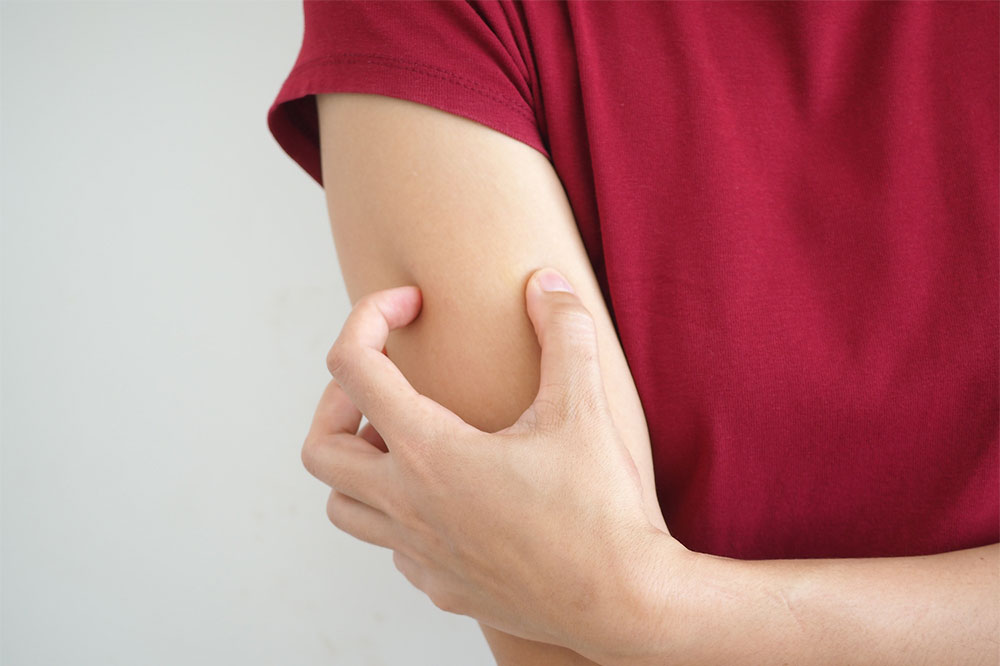
Understanding the signs and symptoms of psoriasis
Psoriasis is a skin disorder that results in itchy, red scaly patches mostly seen in the scalp, trunk, elbows, and knees. It is a chronic disease, and unfortunately, there is no cure for it. Psoriasis goes through cycles, wherein it flares for a few months or weeks and then subsides for a bit before it goes into remission. Treatments are available to manage psoriasis signs. You can include some coping strategies and lifestyle changes too.
Following the reports by National Psoriasis Foundation:
- Mild psoriasis will cover not more than 3 percent of the body.
- Moderate psoriasis will cover about 3-10 percent of the body.
- Severe psoriasis will cover over 10 percent of the body.
Signs and symptoms of psoriasis
Here is a list of all the signs and symptoms of psoriasis.
Rashes
Patches of inflamed, red skin or rashes, covered with silver-colored, loose scales, are the most common psoriasis signs. In people with light-hued skin, psoriasis is seen as red or pink patches with white, silvery scales, whereas in darker-hued people, psoriasis appears as dark brown or purple patches followed by gray scales. In more graver cases, the plaques will grow and merge, in turn covering more significant areas.
Disorders of toenails and fingernails
The toenails and fingernails disorder, mainly seen as pitting or discoloring the nails, is one of the most common psoriasis symptoms. In some people, the nails tend to detach or crumble from the nail bed.
Itching
Psoriasis is derived from the Greek word psora, meaning itch. However, not everyone with psoriasis will experience itching. However, every one in two people with psoriasis will have itching. This results in dead skin build-up, and even when you scratch it, you might not feel relieved. This is in contrast to eczema, wherein people feel better after scratching, but scratching might hurt psoriasis.
Moreover, scratching an inflamed area might also aggravate the itching. When you scratch, the skin might break open, which can result in infection and bleeding. It can also result in the development of psoriasis lesions, also known as the Koebner phenomenon.
Pain
Scratching dry and itchy scales and psoriasis plaques can inflict pain in the areas. These scales are stuck on the skin. So, when you peel them off, you get pinpoint bleeding. This is known as the Auspitz sign. Psoriasis causes inflammation, which thins the area underneath the skin, where capillaries are present. So, when scales come off, the injury will break the blood vessel, and when people scratch this area, it bleeds easily, adding to the discomfort. The location of the plaques also adds to the discomfort.
Broadly, psoriasis is painful as the scales are thick in structure. So, depending on their site, it can hamper the mobility in the area, such as elbows and hands. So, when you touch or move these areas, the plaques will crack and inflict pain.
Psoriatic arthritis
Those with psoriasis might also develop a condition known as psoriatic arthritis. It results in pain, stiffness, and swelling in and around the joints. Following a report by the National Psoriasis Foundation, about 10-30 percent of people with psoriasis also develop psoriatic arthritis. This is another significant reason for pain in psoriasis. Because of psoriatic arthritis, some people also experience swelling in some areas for no apparent reason and pain in the lower back, especially at night. Of course, with movement, it might feel better. However, if you are sitting around, you can still feel it.
Treatment
To ease the discomfort, your doctor might advise you to apply moisturizer. This can ensure that the skin does not become too irritated or dry. The moisturizers include ointment-based moisturizers or cortisone creams. In addition, vitamin D creams, topical retinoids, and coal tar application can also help cure the condition. Light therapy might also help with the treatment. It involves exposure to both UVB and UVA rays. Treatment will also combine light therapies, oral treatment options, and prescription ointments to lower inflammation.




